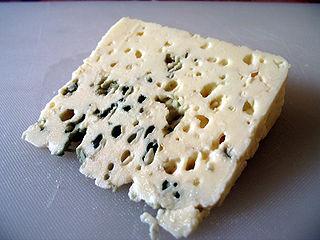
Heading 1
Heading 2
Heading 3
Heading 4
Heading 5
Heading 6
Quote
that is produced with curdled sheep's milk. France obtained the designation of origin in 1925, while in 1979 it was recognized by the AOC and in 1996 by the AOP. This protection restricts the use of the term "roquefort" for other identical or similar cheeses, reserving it for products from the Causses du Aveyron region.

The area of France in which the milk is collected is located around the town of Roquefort-sur-Soulzon (Aveyron) France, close to the city of Millau (Aveyron). It includes the departments of Lozère, Aveyron, Tarn, Aude, Hérault and Gard, while the cheese refining area is limited to the city of Roquefort-sur-Soulzon (Aveyron) France. It is a green paste cheese (fromage à pâte persillée) with an average weight of 2.5 kg. It is made with milk from sheep of the Lacaune breed, the only one capable of adapting to the rigorous climatic conditions that stand out for their strong temperature variations. Then salt and the fungus Penicillium roqueforti are injected into the cheese form, and then matured in the cellars. The dough is stored in the form of balls ("pan", from the French "pain") in open cellars in the limestones of Roquefort-sur-Soulzon. Its optimal tasting period is between the months of April to October after a five-month refining, which favors the action of the fungus in the cheese and the development of the characteristic organoleptic properties; It is an excellent cheese at any time of the year.
La zona de Francia en la que se recolecta la leche está situada alrededor del pueblo de Roquefort-sur-Soulzon (Aveyrón) Francia, cercano a la ciudad de Millau (Aveyrón). Comprende los departamentos de Lozère, Aveyrón, Tarn, Aude, Hérault y Gard, mientras que la zona de afinado del queso queda circunscrita a la ciudad de Roquefort-sur-Soulzon (Aveyrón) Francia.
Es un queso de pasta verde (fromage à pâte persillée) con un peso medio de 2,5 kg. Se elabora con leche de oveja de la raza Lacaune, la única capaz de adaptarse a las rigurosas condiciones climáticas que destacan por sus fuertes variaciones de temperatura. Luego a la forma de queso se le inyecta la sal y el hongo Penicillium roqueforti, para luego madurarlo en las bodegas.
| asdasd | asdas |
| asd | asdasd |
La masa se guarda en forma de bolas ("pan", del francés "pain") en bodegas abiertas en las calizas de Roquefort-sur-Soulzon. Su período de degustación óptima se encuentra entre los meses de abril a octubre tras un afinado de cinco meses, lo que favorece la acción del hongo en el queso y el desarrollo de las propiedades organolépticas tan características; es un queso excelente en cualquier época del año.

